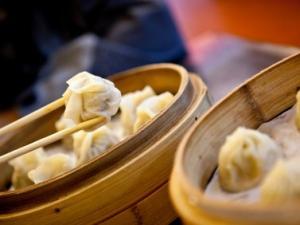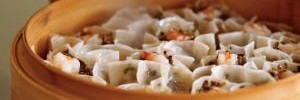Steaming with different types of steamer
The culinary technique of steaming food is steeped in yin-yang philosophy. In China, the belief is that fried foods must be counteracted by those that contain less or no oil, and are therefore healthier. Steaming food with steamer uses minimal amounts of flavorings, allowing the natural flavors of the food to come through. It is an excellent way of cooking the seafood that is so prolific in China’s coastal and inland riverine areas. Lean meats and lean poultry joints become more succulent and flavorsome when steamed, and no nutrients are lost, as they are with boiling. Last but certainly not least, steaming requires very little skill from the cook. Clearly, there are many good reasons to incorporate more steamed dishes in your culinary repertoire.
 Bamboo Steamers
Bamboo Steamers
These steamers are traditionally made of woven bamboo and come in various sizes between 15cm (6in) and 35cm (14in) in diameter. The larger the steamer, the larger the wok or saucepan that needs to be used with it. Generally, steamers of about 24cm (10in) diameter will suffice for most domestic cooking needs. The wonderful thing about steamers is that you can stack them one on top of the other, and cook various foods using the same steam power. Steamers need only be rinsed in cold water and dried after use. Never use detergents to wash bamboo steamers, as they readily absorb cleaning agents.
Steaming with Lotus Leaves
The large dried leaf of the lotus plant looks like a grey-green fan measuring some 40cm (16in) in diameter. After soaking, it is extremely tough and pliable, and suitable for wrapping all kinds of foods, to which it imparts a faint floral perfume during steaming. The lotus plant is held in reverence by Buddhists and Taoists, and is symbolically related to Guanyin, the goddess of mercy, who is regarded as the patron saint of seafarers in some parts of China.
Aluminum Steamer
This modern version of the bamboo steamer comes in multiple layers and has a high domed lid; there is also a bottom section to hold water, so it can be used without a wok. Although it is useful for similar steaming jobs, the solid lid tends to create too much condensation, so that water drops back onto the food, resulting in an unwanted ‘soup’. You can prevent this by using the aluminum steamer in conjunction with the lid of a bamboo steamer, by puncturing several small holes in the metal to create a vent.
One-Portion Aluminum Steamer
A handy small steamer for cooking dim sum and reheating, this is just large enough to hold two small dumplings. Several of these little steamers can fit inside a large bamboo steamer to keep individual dim sum servings hot without letting them overcook.
Little Metal Cups
These small cups are used for steaming individual portions of savory or sticky rice flour cakes, a popular Chinese street food. The cakes are unmoulded onto plates or dried palm leaves, or eaten with a spoon straight from the cup.
